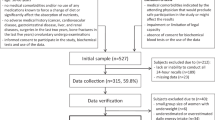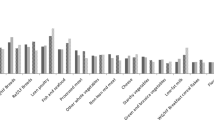Abstract
Objectives:
To investigate the association between added sugar and macronutrient and micronutrient intakes, and to assess whether added sugar intake is related to biochemical indices of nutritional status, Mini-Nutritional Assessment (MNA) score, body mass index (BMI) and performance on physical function tests.
Design:
A cross-sectional, analytical study.
Setting and subjects:
Convenient sample of 285 institutionalised and community-dwelling black South African men and women aged 60+ y.
Methods:
An interviewer-administered 24-h dietary recall and MNA were performed. Serum albumin, vitamin B12, ferritin, cholesterol, haemoglobin, red blood cell (RBC) folate and plasma vitamin C were measured. Handgrip strength, BMI, ‘sit-to-stand’ and ‘get-up-and-go’ tests were measured. Outcome variables were analysed according to tertiles of added sugar, in grams and as a percentage of total energy (% E).
Results:
In each tertile of sugar intake, mean MNA score fell in the ‘at-risk’ classification. In women, energy, protein, % E protein, fibre, thiamin, riboflavin, niacin, vitamin B6, folate, pantothenic acid, biotin, vitamin C, calcium, iron, magnesium, phosphorus, zinc, copper and selenium intake were significantly lowest in subjects in the highest % E sugar tertile. In men, no differences were found for micronutrient intake according to tertiles of total added sugar or % E added sugar. Physical function declined with increasing sugar intake, and suboptimal RBC folate and plasma ascorbic acid status was associated with increasing sugar intake (in women). No relationship was found between added sugar intake and the very high prevalence (65%) of obesity in women.
Conclusion:
A nutrient-diluting effect of added sugars intake was demonstrated in elderly black South African women. Further studies in this population are required in order to develop food-based dietary guidelines, which include messages on added sugar intake.
This is a preview of subscription content, access via your institution
Access options
Subscribe to this journal
Receive 12 print issues and online access
$259.00 per year
only $21.58 per issue
Buy this article
- Purchase on Springer Link
- Instant access to full article PDF
Prices may be subject to local taxes which are calculated during checkout

Similar content being viewed by others
References
Alexy U, Sichert-Hellert W & Kersting M (2002): Fortification masks nutrient dilution due to added sugars in the diet of children and adolescents. J. Nutr. 132, 2785–2791.
Alexy U, Sichert-Hellert W & Kersting M (2003): Association between intake of added sugars and intakes of nutrients and food groups in the diets of German children and adolescents. Br. J. Nutr. 90, 441–447.
Baghurst KI, Baghurst PA & Record SJ (1992): Demographic and nutritional profiles of people consuming varying added levels of added sugars. Nutr. Res. 12, 1455–1465.
Bester FCJ, Weich DJV & Danhauser A (1993): Nutrient intakes of elderly blacks on the Orange Free State. S. Afr. J. Clin. Nutr. 6, 6–11.
Bolton-Smith C & Woodward M (1995): Antioxidant vitamin adequacy in relation to sugar consumption. Eur. J. Clin. Nutr. 49, 124–133.
Bourne LT (1996): Dietary intake in an urban African population in South Africa—with special reference to the nutrition transition. PhD thesis, University of Cape Town,.
Bowman SA (1999): Diets of individuals based on energy intakes from added sugars. Fam. Econ. Nutr. Rev. 12, 31–38.
Broderick K (2002): Correlation between scores on two screening tools for dementia in Xhosa women. S. Afr. J. Occup. Ther. 32, 8–13.
Brooke P & Bullock R (1999): Validation of a 6-item Cognitive Impairment Test with a view to primary care usage. Int. J. Geriatr. Psychiatry 14, 936–940.
Charlton KE, Bourne LT, Steyn K & Laubscher R (2001): Poor nutritional status in older black South Africans. Asia Pac. J. Clin. Nutr. 10, 31–38.
Charlton KE, Kolbe T & Nel H (2003): Nutritional Status of Older Black South Africans: Towards the Development of a Nutrition Screening Tool for Use in this Population Research Report submitted to the Minimum Data Set Project of the World Health Organization, Observatory: University of Cape Town (unpublished).
Charlton KE & Rose D (2001): Nutrition among older adults in Africa: the situation at the beginning of the millenium. J. Nutr. 131 (Suppl), 2424S–2428S.
Charlton KE & Lambert EV (1999): Validation of a food frequency questionnaire in older South Africans. S. Afr. Med. J. 89, 184–189.
Charlton KE, Wolmarans P & Lombard CJ (1998): Evidence of nutrient dilution with a high sugar intake in older South Africans. J. Hum. Nutr. Diet. 11, 331–343.
Department of Health and Social Security (1989): Dietary Sugars and Human Disease Committee on Medical Aspects of Food Policy. Report on Health and Social Subjects 37, London: HMSO.
Department of Health (1992): The Nutrition of Elderly People. London: HMSO.
Emmett PM & Heaton KW (1995): Is extrinsic sugar a vehicle for dietary fat? Lancet 345, 1537–1540.
FAO/WHO/UNU (1985): Energy and Protein Requirements Report of a Joint Expert Consultation. Technical Report Series No. 724 Geneva: WHO.
Ferreira M, Møller V, Prinsloo FR & Gillis LS (1992): Multidimensional Survey of Elderly South Africans, 1990–91: Key Findings. Cape Town: HSRC/UCT Centre for Gerontology.
Gibson S (2001): Dietary sugars and micronutrient dilution in normal adults aged 65 years and over. Pub. Health Nutr. 4, 1235–1244.
Gibson SA (1997): Do diets high in sugar compromise micronutrient intakes? J. Hum. Nutr. Diet. 10, 125–133.
Goldberg GR, Black AE, Jebb SA, Cole TJ, Murgatroyd PR, Coward WA & Prentice AM (1991): Critical evaluation of energy intake data using fundamental principles of energy physiology. 1. Derivation of cut-off limits to identify under-recording. Eur. J. Clin. Nutr. 45, 569–581.
Guigoz Y, Vellas B & Garry PJ (1996): Assessing the nutritional status of the elderly: the Mini Nutritional Assessment as part of the geriatric evaluation. Nutr. Rev. 54, S59–S65.
Guralnik JM, Ferrucci L, Simonsick EM, Salive ME & Wallace RB (1995): Lower extremity function over the age of 70 years as a predictor of subsequent disability. N. Engl. J. Med. 332, 556–561.
Institute of Medicine (1998): Dietary Reference Intakes for Calcium, Phosphorus, Magnesium, Vitamin D and Fluoride Food and Nutrition Board Washington, DC: National Academy Press.
Institute of Medicine (2000): Dietary Reference Intakes for Vitamin C, Vitamin E, Selenium, and Carotenoids Food and Nutrition Board, Washington, DC: National Academy Press.
Institute of Medicine (2002): Dietary Reference Intakes for Energy, Carbohydrate, Fibre, Fat, Fatty Acids, Cholesterol, Protein and Amino Acids Food and Nutrition Board, Washington, DC, National Academy Press.
Johnson S & van der Westhuizen J (1992): Nutritional evaluation of the black elderly in a rural village. S. Afr. J. Food Sci. Nutr. 1, 23–28.
Katz SC & Stroud MW (1989): Functional assessment in geriatrics: a review of progress and directions. J. Am. Geriatr. Soc. 37, 267–271.
Kruger M, Sayed N, Langenhoven M & Holing F (1998): Composition of South African Foods. Vegetables and Fruit. Tygerberg: Medical Research Council.
Labadarios D, Steyn NP, Maunder E, MacIntyre U, Swart R, Gericke G, Huskisson J, Dannhauser A, Voster HH & Nesamvuni AE (2000): The National Food Consumption Survey (NFCS): Children Aged 1–9 years, South Africa, 1999. Pretoria: Department of Health, Directorate: Nutrition.
Langenhoven MJ, Conradie PJ, Wolmarans P & Faber M (1991a): MRC Food Quantities Manual 2nd Edition, Tygerberg: Medical Research Council.
Langenhoven M, Kruger M, Gouws E & Faber M (1991b): MRC Food Composition Tables 3rd Edition, Parow: Medical Research Council.
Lawton MP & Brody EM (1969): Assessment of older people: self-maintaining and instrumental activities of daily living. Gerontologist 9, 179–186.
Mahoney FI & Barthel DW (1965): Functional evaluation: the Barthel Index. Med. State Med. J. 14, 61–65.
Mathias S, Nayak USL & Isaacs B (1986): Balance in the elderly patients: the ‘get-up-and-go’ test. Arch. Phys. Med. Rehab. 67, 387–389.
Schofield WN, Schofield C & James WPT (1985): Basal metabolic rate prediction. J. Hum. Nutr. Clin. Nutr. 39C (Supp 1), S1–S96.
Sheiham A (2001): Dietary effects on dental diseases. Pub. Health Nutr. 4, 569–591.
South African Medical Association (SAMA) and LASSA Working Group (2000): Diagnosis, Management and Prevention of the Common Dyslipidaemias in South Africa—Clinical Guidelines 2000. Pretoria: SAMA.
Steyn NP, Myburgh NG & Nel JH (2003): Evidence to support a food-based dietary guideline on sugar consumption in South Africa. Bull. World Health Organ. 81, 599–608.
Venter CS, McIntyre UE & Vorster HH (2000): The development and testing of a food portion photograph book for use in an African population. J. Hum. Nutr. Diet. 13, 205–218.
World Health Organization (1968): Nutritional Anaemias: Report of a World Health Organization Scientific Group, Technical Report Series No. 405, Geneva: World Health Organization.
World Health Organization (1997): GEMS/Food Regional Diets. Regional Per Capita Consumption of Raw and Semi-processed Agricultural Commodities Prepared by the Global Environmental Monitoring and Assessment Programme of Food Safety and Food Aid. WHO/FSF/FOS/98.3, Geneva: World Health Organization.
Acknowledgements
Financial support for this study was provided by the Minimum Data Set (MDS) Project of the World Health Organization. Financial support for the MDS Project was provided under a grant from the Behavioral and Social Research Program of the US National Institute on Aging, within the US Department of Health and Human Services National Institutes of Health, through an Inter-agency Agreement with the World Health Organization.
Author information
Authors and Affiliations
Corresponding author
Additional information
Guarantor: KE Charlton.
Contributors: TLKA co-ordinated data collection, performed physical function tests and was responsible for subject recruitment. JHN performed data entry and statistical analyses.
Rights and permissions
About this article
Cite this article
Charlton, K., Kolbe-Alexander, T. & Nel, J. Micronutrient dilution associated with added sugar intake in elderly black South African women. Eur J Clin Nutr 59, 1030–1042 (2005). https://doi.org/10.1038/sj.ejcn.1602208
Received:
Revised:
Accepted:
Published:
Issue Date:
DOI: https://doi.org/10.1038/sj.ejcn.1602208
Keywords
This article is cited by
-
Association between added sugar intake and micronutrient dilution: a cross-sectional study in two adult Swedish populations
Nutrition & Metabolism (2020)
-
Obesity Prevention in Older Adults
Current Obesity Reports (2016)
-
Evidence to support a food-based dietary guideline on sugar consumption in South Africa
BMC Public Health (2012)
-
Carbohydrate intake and obesity
European Journal of Clinical Nutrition (2007)



